Poodles are an intelligent, lively breed most recognized for their curly, hypoallergenic fur, funny hairstyles and zany dye jobs. In the world of poodle breeding, training and dog shows, a major focus of the breed is the many colors they come in. The American Kennel Club (AKC) has standardized poodle colors that all depend on the proper genetic combinations as well as a few anomalies. Learn about the different poodles colors below and how each one has come to be!
Black

Color Family: Black
Parent Colors: Black and anything else, but avoid silve
The most common poodle color is black. In general, darker tones are genetically dominant, meaning they’re more likely to manifest when mixed with other colors. The same logic applies to hair colors in humans. With that said, black poodles with a recessive gene for fading can become silver or blue as they age so the color doesn’t always last.
Brown

Color Family: Brown
Parent Colors: Brown and black
Like black poodles, brown poodles are quite common due to a dominant gene. Also similar to black poodles, some brown poodles have a gene that fades their fur over time, turning them cafe au lait or silver. Breeding with colors like silver introduces this gene and makes the dogs less desirable in dog shows and other competitions.
White

Color Family: White
Parent Colors: White, silver, black, blue
White poodles are quite popular among dog owners, so they aren’t very rare despite the fact that they’re recessive. This is possible because breeders have special techniques to keep genetic anomalies out of the pool so the puppies will always be white. Unfortunately, the color has some links to deafness in dogs. Additionally, there are various shades of white and dog breeders are quick to point out that a cream poodle is distinct from a truly white one.
Blue

Color Family: Grey
Parent Colors: Silver, silver-beige, white, black and blue
Just as a Russian Blue cat isn’t actually blue, neither is a blue poodle (crazy dye jobs aside). Instead, a blue poodle is a deeper shade of silver and possesses the same gene that fades black fur over time, although they only possess one of these genes, which allows them to stay darker. Some blue poodles have a brown hue as they mature, making them difficult to register with the American Kennel Club as truly blue.
Silver

Color Family: Grey
Parent Colors: Silver, silver-beige, white and blue
Silver poodles are some of the most highly desirable, but they’re difficult to find in nature because they require two recessive genes. Silver poodles are born black and have two genes that make their color fade over time, usually within a year or two of life.
Silver Beige
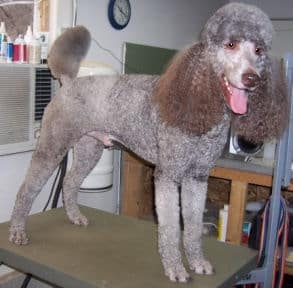
Color Family: Silver
Parent Colors: Silver beige, silver, cafe au lait or blue
Silver beige is developed by breeding two silver or blue poodles that also carry the gene for a brown coat with the recessive fading gene. As a result, all poodles born in this litter will be silver beige. Like most other poodles in this color family, the puppies are born black or dark brown and fade over time. A true silver beige will look appear beige with silver fur spattered in.
Cafe au Lait
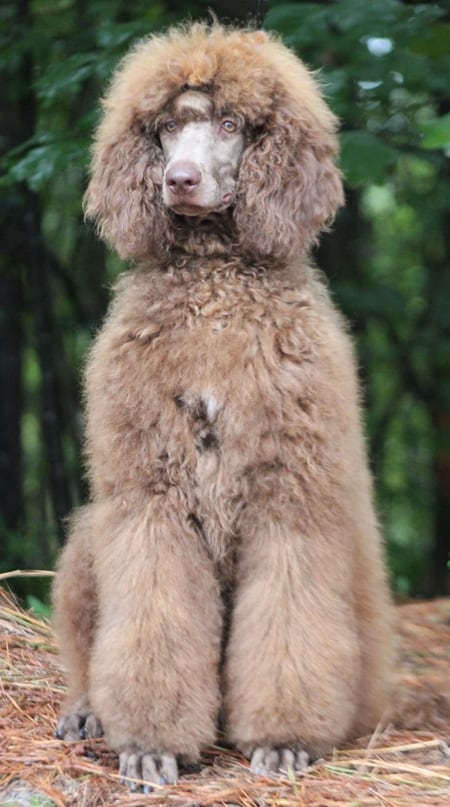
Color Family: Brown
Parent Colors: Cafe au lait, brown, silver and blue
Cafe au Lait is the result of a fading gene in brown coats. Unlike silver beige, this color doesn’t have silver but is closer to a dark cream hue. In general, the poodles match the description of “coffee with milk,” but the color changes over time as is true with most faded coat colors.
Sable

Color Family: Varies
Parent Colors: Unclear, but most likely sable and sable
Sable isn’t a color, but describes poodles of various hues with black tipped fur. To put it another way, a sable poodle has the opposite of frosted tips. Although the sable characteristic comes from a dominant gene, these kinds of poodles are quite rare. This is probably because the black tips fade as the dog matures so older poodles with the sable gene might not look like they have it. Additionally, many breeders don’t know much about the sable gene so sable poodles are difficult to breed.
Cream
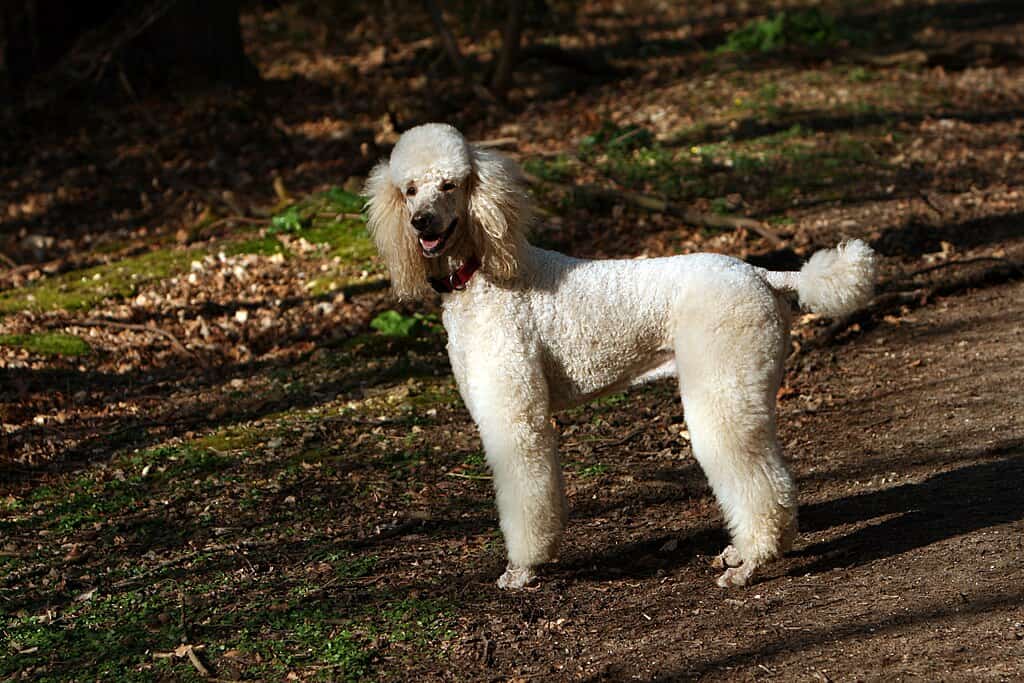
Color Family: Brown
Parent Colors: Cream, white, apricot
Cream is one of the rarer poodle colors because it requires a recessive gene as well as specific breeding. It’s usually attained by mixing the fading gene found in silver poodles with red or by introducing the chinchilla gene, which fades apricot fur. Cream is also rare because it’s usually mistaken for white or apricot, meaning that cream poodles are easily miscategorized as the incorrect color.
Red

Color Family: Red
Parent Colors: Red and black
Red poodles are quite rare and vary in vibrancy. They usually carry a fading gene that reduces the redness of their coats over time, which also occurs in black poodles that turn silver. While some believe the red and apricot genes are related, breeders have posited that red poodles are a result of a separate gene nicknamed “Rufus.” The color is recessive. The American Kennel Club didn’t accept red as a poodle color until 1980
Apricot
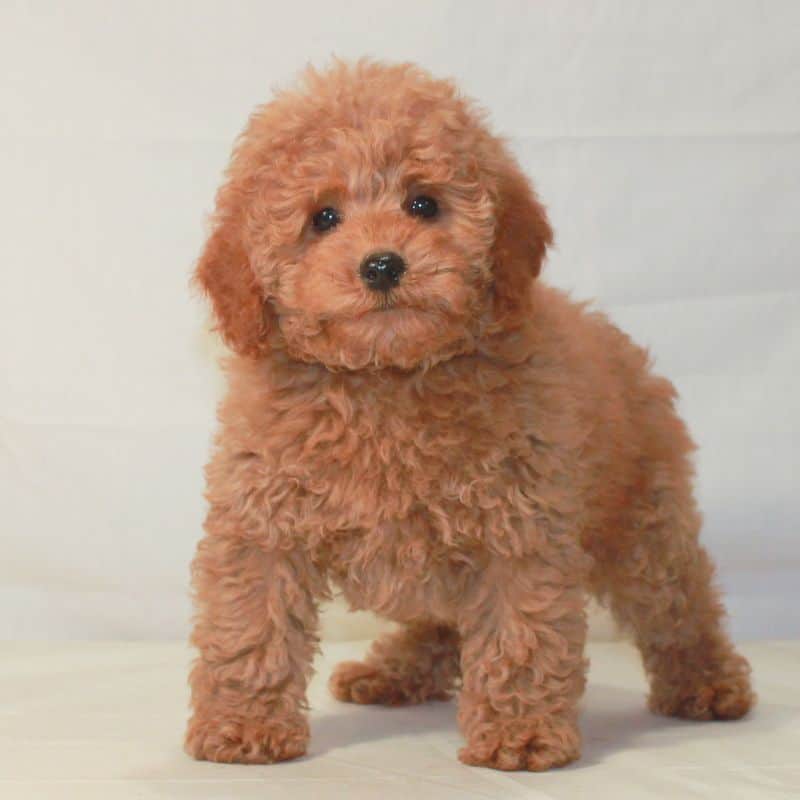
Color Family: Red
Parent Colors: Apricot and red
Apricot poodles are the rarest in the world. Caused by a recessive gene, this color comes off as a very light red that borders on cream. As dogs have been genetically bred for generations to have certain characteristics, apricot is hypothesized to be the last color developed in poodles. The first apricot poodle on record was Sowden Yellow Gall in 1898.
This article originally appeared on Rarest.org.
More from Rarest.org
15 Most Expensive Purebred Dogs Ever

In the world of canine companionship, certain breeds stand out not only for their unique characteristics and loyal personalities but also for their hefty price tags. From majestic Tibetan Mastiffs to elegant Salukis, the demand for purebred dogs with exceptional lineage and desirable traits has driven prices to astonishing heights. Read More
10 Rarest Game Consoles in the World

Enter the realm of gaming rarity as we embark on a journey to uncover some of the most elusive treasures in the world of video game consoles. From prototypes that never made it to market to limited edition variants with exclusive features, these ten consoles stand out as some of the most sought-after collector’s items among gaming enthusiasts. Read More
1996 Washington Quarter Value Guide
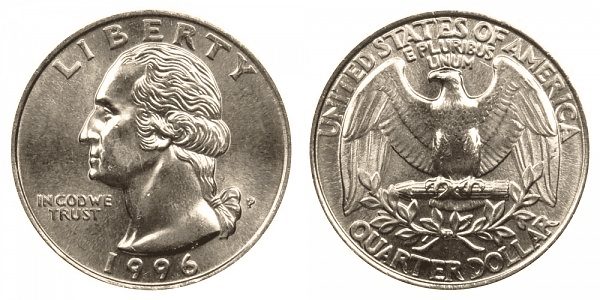
The 1996 quarter is an interesting coin regarding history, value, and composition. Thus, it is not surprising that some people are interested in adding this coin to their collection. Read More
